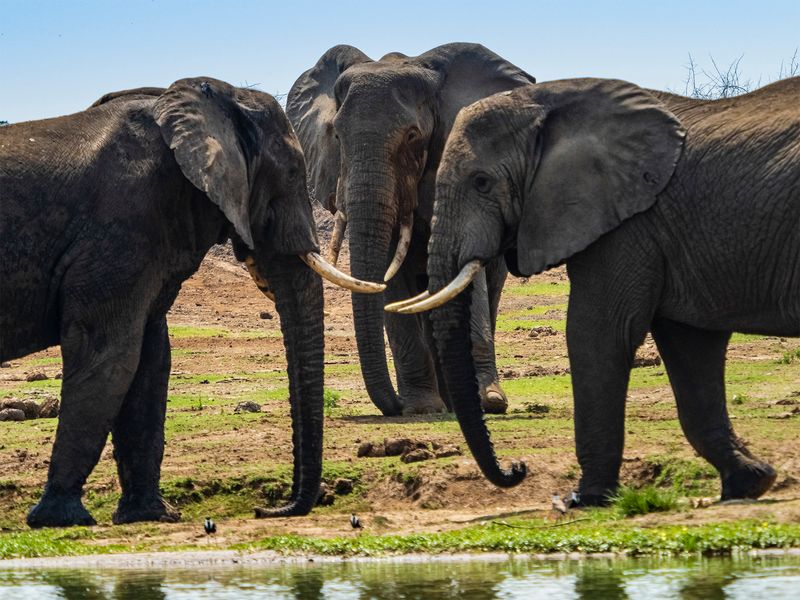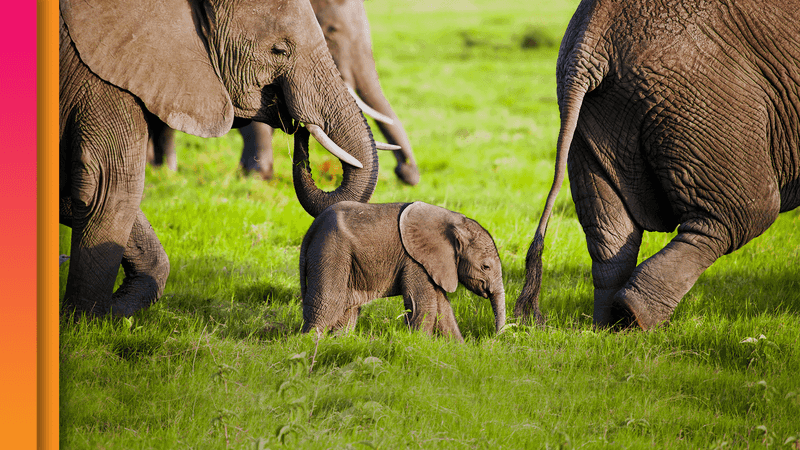Elephants have a family bond that’s stronger than most humans can imagine. These gentle giants don’t just live in groups—they thrive together in a web of love, loyalty, and shared wisdom.
The matriarch is the heart of the herd, leading with experience and a deep understanding of the land. Every family member, from the tiniest calf to the oldest, plays a role. They protect each other, grieve together, and celebrate life as one.
But their family life isn’t just about safety and survival. Elephants have an emotional intelligence that allows them to form deep friendships and even show empathy for others. Their relationships are built on trust, communication, and a deep sense of connection.
Want to know more about the amazing ways elephants live as a family? Here are 15 fascinating facts that will make you see these magnificent creatures in a whole new light.
The Matriarch’s Role

In an elephant herd, the matriarch is the oldest and often the wisest female. Her leadership is crucial for the survival and success of the group. She leads the way to water, food, and safety, drawing on her years of experience.
Her decisions can mean the difference between life and death during challenging times, such as droughts. Her memory helps the herd navigate vast landscapes. The matriarch’s role extends beyond practical matters; she is a pillar of strength and guidance, teaching younger members essential survival skills.
Strong Family Bonds

Elephant families are known for their strong bonds, often staying together for life. These connections are not just social; they enhance the herd’s survival. Their emotional ties manifest through touching, vocalizations, and coordinated movements.
When an elephant is distressed, others offer comfort by wrapping their trunks around it. Such empathy is a testament to their intelligence.
These bonds also play a role in teaching young elephants critical skills. By observing and mimicking older members, the young learn vital survival techniques, reinforcing the family’s cohesion and collective wisdom.
Communication Skills

Elephants communicate using a sophisticated array of sounds, body language, and even seismic signals. This complex system allows them to convey emotions, warnings, and instructions over long distances.
Low-frequency rumbles can travel through the ground, reaching elephants miles away. Such messages might alert others to danger or call them to join the group.
Trumpeting and ear flapping add layers to their expressive communication. These skills are vital for maintaining the unity and safety of the herd, showcasing their adaptability and intelligence in various environments.
Elephant Nurseries

Elephant nurseries are gatherings of young calves watched over by several adult females. These nurseries provide a safe environment for the calves to play, learn, and socialize.
Play is crucial for their development, helping them acquire skills like foraging and social interactions. The adult females teach and protect the young ones, ensuring their safety and education.
Such nurseries also strengthen bonds among females, as they collaborate in caring for the next generation. This cooperative rearing highlights the elephants’ communal lifestyle and the importance of shared responsibilities.
Emotional Intelligence

Elephants are renowned for their emotional intelligence, displaying behaviors akin to human emotions. They express joy, grief, empathy, and even compassion within their herds.
When a member dies, elephants often engage in mourning rituals, showing respect and remembrance. They exhibit joy through play and social interactions.
Empathy is evident when they comfort distressed individuals, using touch and sound. This emotional depth fosters strong familial bonds, ensuring the herd’s unity. It also allows them to interact harmoniously with other species and adapt to changing environments.
Lifelong Learning

Elephants are lifelong learners, continuously adapting to their environment. Their intelligence enables them to solve complex problems, use tools, and even learn from past experiences.
Young elephants observe and imitate older members, gaining knowledge about foraging, migration routes, and social dynamics. This learning process is crucial for their survival in the wild.
Adults also continue to learn, adapting to environmental changes and threats. This capacity for learning and adaptation underscores their resilience and contributes to the herd’s overall success.
Protecting the Young

Protecting the young is a primary concern for elephant herds. Adult elephants often form protective circles around calves when they sense danger, showcasing their defensive strategies.
This tactic not only shields the young but also deters predators. Such coordinated behavior highlights their cooperative nature.
The sense of responsibility extends to all herd members, not just the mothers. This collective protection strengthens the group’s defense mechanisms and ensures the survival of the next generation, demonstrating the value of teamwork and unity.
Memory and Migration

Elephants possess remarkable memories, crucial for navigating vast landscapes and seasonal migrations. The matriarch’s knowledge of ancient routes ensures access to food and water during migration.
These migratory paths are learned and remembered across generations, demonstrating the elephants’ cognitive abilities. Such memory is vital for survival, especially in changing climates.
The ability to recall these routes allows herds to thrive in diverse habitats, supporting the ecosystem’s balance. This memory-driven migration underscores the intelligence and adaptability of elephants in the wild.
Complex Social Structures

Elephant herds are structured around complex social hierarchies, ensuring cooperation and stability. These structures are based on age, experience, and familial ties, with the matriarch at the top.
Social roles are well-defined, with younger elephants learning their places within the group. Communication and respect for hierarchy help maintain harmony.
Such organization is essential for making collective decisions, like migration or defense strategies. This intricate social web reflects the elephants’ intelligence and emphasizes the importance of cooperation for survival and success.
Caring for the Elderly

Elephants demonstrate compassion by caring for their elderly, ensuring their well-being within the herd. This care includes helping them move, find food, and stay safe.
The elderly elephants, in turn, offer wisdom and guidance, drawing from their life experiences. This reciprocal relationship enhances the herd’s knowledge and resilience.
By valuing their elders, elephants maintain a rich cultural memory, vital for survival. Such care emphasizes the importance of every member, fostering a supportive and harmonious community.
Cooperative Childcare

In elephant herds, cooperative childcare is a common practice. Multiple females, often relatives, share the responsibility of raising calves, providing protection and education.
This collaboration allows mothers to rest, forage, or scout for resources, knowing their young are safe. Such teamwork strengthens social bonds among females and ensures the calves’ well-being.
Cooperative childcare reflects the elephants’ communal lifestyle, where the success of the group is prioritized over individual efforts. This approach enhances the survival chances of the young and supports the herd’s overall stability.
Mourning Rituals

Elephants are known to mourn their dead, engaging in rituals that show respect and remembrance. These rituals can include touching, vocalizing, and standing vigil over deceased members.
Such behavior indicates a deep emotional connection and understanding of loss. It helps strengthen the bonds among the living, reaffirming their solidarity.
Mourning rituals also serve as a learning experience for younger elephants, teaching them about life, death, and familial responsibilities. This emotional awareness adds depth to their social interactions and highlights their empathy.
Playful Adolescence

Adolescent elephants are known for their playful behavior, engaging in activities like mock fighting, water play, and mud baths. This playfulness is vital for their development.
Through play, young elephants learn social cues, strengthen muscles, and practice survival skills. Such interactions are essential for building relationships and integrating into the herd.
Playful adolescence prepares them for adulthood, ensuring they are physically and socially equipped to contribute to the group’s success. This phase of life highlights the importance of play as a tool for growth and learning.
Cross-Generational Learning

Elephants engage in cross-generational learning, where knowledge is passed down from elders to the young. This includes migration routes, survival tactics, and social etiquette.
The young observe and imitate, gaining invaluable insights from experienced members. Such learning ensures the continuity of cultural practices and survival strategies.
Cross-generational learning fosters a sense of community, reinforcing the bonds between different age groups. It highlights the importance of preserving knowledge and the role of the elders in guiding the herd.
Tool Use

Elephants are innovative, using tools to aid in various tasks. They use their trunks to manipulate objects, such as stripping bark or digging for water.
This tool use demonstrates their problem-solving abilities and adaptability. It allows them to access resources and overcome challenges in their environment.
Their intelligence is evident in their ability to use tools, showcasing a level of sophistication in their interaction with the world. Tool use is a testament to their cognitive skills and contributes to their survival in diverse habitats.

